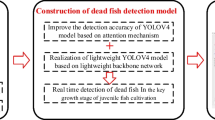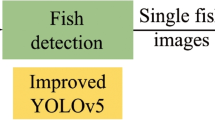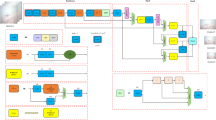Abstract
Object detection adopting deep-learning has strongly promoted the development of intensive aquaculture. However, shrimp larvae, as an important aquatic organism, are more difficult to be detected than others. On the one hand, they have indeed small sizes, which will cause them to be easily ignored due to the background noise pollution. On the other hand, affected by environmental factors and the fact that shrimp larvae like to move fast as jum**, the images of shrimp larvae often appear blurry. In order to obtain better shrimp larvae detection performance, we propose an improved anchor-free method called CAGNet in this paper. Compared with YOLOX_s, three structures including backbone, neck, and head have been improved in the proposed method. Firstly, we ameliorate the backbone by adding a coordinate attention module to extract more location information and semantic information of shrimp larvae at different levels. Secondly, an adaptively spatial feature fusion module is introduced to the neck. It can adaptively integrate effective shrimp larvae features from different levels and suppress the interference of conflicting information arising from the background. Moreover, in the head, we use GIoU module instead of conventional IoU for more accurate bounding box regression. We conducted experiments by collecting shrimp larvae data from a real aquaculture farm. Compared with the general object detection methods and previous related research, CAGNet has achieved better performance in Precision, Recall, F1 Score, and AP@0.5:0.95. Hence, the proposed method can be effectively applied to shrimp larvae detection in intensive aquaculture.









Similar content being viewed by others
Data Availability
On reasonable request, the experimental data is available from the corresponding author.
References
Armalivia S, Zainuddin Z, Achmad A et al (2021) Automatic counting shrimp larvae based you only look once (yolo). In: 2021 Int Conf Artif Intell Mechatron Syst (AIMS), pp 1–4. https://doi.org/10.1109/AIMS52415.2021.9466058
Awalludin EA, Yaziz MYM, Rahman NRA et al (2019) Combination of canny edge detection and blob processing techniques for shrimp larvae counting. In: 2019 Int Conf Signal Image Process Appl (ICSIPA), pp 308–313. https://doi.org/10.1109/ICSIPA45851.2019.8977746
Bochkovskiy A, Wang C, Liao HM (2020) Yolov4: optimal speed and accuracy of object detection. https://doi.org/10.48550/ar**v.2004.10934
Chen Z, Li Z, Yang Z et al (2022) Research on yolov5-based object detection method for shrimp industrial farming. Mar Fish 44(5):610. https://doi.org/10.13233/j.cnki.mar.fish.20220520.001
Dosovitskiy A, Beyer L, Kolesnikov A et al (2021) An image is worth 16x16 words: transformers for image recognition at scale. In: 2021 Int Conf Learn Represent (ICLR)
FAO (2022) The state of world fisheries and aquaculture 2022. State of World Fisheries and Aquaculture (FAO)
Ge Z, Liu S, Wang F et al (2021) YOLOX: exceeding YOLO series in 2021. https://doi.org/10.48550/ar**v.2107.08430
Hicks CC, Cohen PJ, Graham N et al (2019) Harnessing global fisheries to tackle micronutrient deficiencies. Nat 574(7776):1–4. https://doi.org/10.1038/s41586-019-1592-6
Hou Q, Zhou D, Feng J (2021) Coordinate attention for efficient mobile network design. In: 2021 IEEE/CVF Conf Comput Vis Pattern Recognit (CVPR), pp 13,713–13,722. https://doi.org/10.1109/CVPR46437.2021.01350
Hu J, Shen L, Sun G (2018) Squeeze-and-excitation networks. In: 2018 IEEE/CVF Conf Comput Vis Pattern Recognit (CVPR), pp 7132–7141. https://doi.org/10.1109/CVPR.2018.00745
Hu WC, Chen LB, Hsieh MH et al (2023) A deep-learning-based fast counting methodology using density estimation for counting shrimp larvae. IEEE Sens J 23(1):527–535. https://doi.org/10.1109/JSEN.2022.3223334
Isa IS, Norzrin NN, Sulaiman SN et al (2020) Cnn transfer learning of shrimp detection for underwater vision system. In: 2020 Int Conf Inf Technol, Adv Mech Electr Eng (ICITAMEE), pp 226–231. https://doi.org/10.1109/ICITAMEE50454.2020.9398474
Jocher G, Stoken A, Borovec J et al (2020) ultralytics/yolov5: v3.1–bug fixes and performance improvements. https://doi.org/10.5281/zenodo.4154370
Khantuwan W, Khiripet N (2012) Live shrimp larvae counting method using co-occurrence color histogram. In: 2012 9th Int Conf Electr Eng/Electron, Comput, Telecommun Inf Technol, pp 1–4. https://doi.org/10.1109/ECTICon.2012.6254280
Li W, Chen Y, Hu K et al (2022) Oriented reppoints for aerial object detection. In: 2022 IEEE/CVF Conf Comput Vis Pattern Recognit (CVPR), pp 1819–1828. https://doi.org/10.1109/CVPR52688.2022.00187
Lin T, Dollár P, Girshick RB et al (2017) Feature pyramid networks for object detection. In: 2017 IEEE/CVF Conf Comput Vis Pattern Recognit (CVPR), pp 936–944. https://doi.org/10.1109/CVPR.2017.106
Lin TY, Goyal P, Girshick R et al (2020) Focal loss for dense object detection. Trans Pattern Anal Mach Intell 42(2):318–327. https://doi.org/10.1109/TPAMI.2018.2858826
Liu S, Huang D, Wang Y (2019) Learning spatial fusion for single-shot object detection. https://doi.org/10.48550/ar**v.1911.09516
Liu Z, Hu H, Lin Y et al (2022) Swin transformer V2: scaling up capacity and resolution. In: 2022 IEEE/CVF Conf Comput Vis Pattern Recognit (CVPR), pp 11,999–12,009. https://doi.org/10.1109/CVPR52688.2022.01170
Mei Y, Sun B, Li D et al (2022) Recent advances of target tracking applications in aquaculture with emphasis on fish. Comput Electron Agric 201(107):335. https://doi.org/10.1016/j.compag.2022.107335
Morimoto T, Zin TT, Itami T (2018) A study on abnormal behavior detection of infected shrimp. In: 2018 IEEE Glob Conf Consum Electron (GCCE), pp 291–292. https://doi.org/10.1109/GCCE.2018.8574860
Naylor RL, Hardy RW, Buschmann AH et al (2021) A 20-year retrospective review of global aquaculture. Nat 591(7851):551–563. https://doi.org/10.1038/s41586-021-03308-6
Nguyen K, Nguyen C, Wang C et al (2020) Two-phase instance segmentation for whiteleg shrimp larvae counting. In: 2020 Int Conf Consum Electron (ICCE), pp 1–3. https://doi.org/10.1109/ICCE46568.2020.9043075
Raman V, Perumal S, Navaratnam S et al (2016) Computer assisted counter system for larvae and juvenile fish in malaysian fishing hatcheries by machine learning approach. J Comput 11(5):423–431. https://doi.org/10.17706/jcp.11.5.423-431
Redmon J, Farhadi A (2018) Yolov3: an incremental improvement. https://doi.org/10.48550/ar**v.1804.02767
Ren S, He K, Girshick R et al (2017) Faster r-cnn: towards real-time object detection with region proposal networks. Trans Pattern Anal Mach Intell 39(6):1137–1149. https://doi.org/10.1109/TPAMI.2016.2577031
Rezatofighi H, Tsoi N, Gwak J et al (2019) Generalized intersection over union: a metric and a loss for bounding box regression. In: 2019 IEEE/CVF Conf Comput Vis Pattern Recognit (CVPR), pp 658–666. https://doi.org/10.1109/CVPR.2019.00075
Si G, Zhou F, Zhang Z et al (2022) Tracking multiple zebrafish larvae using yolov5 and deepsort. In: 2022 8th Int Conf Autom, Robot Appl (ICARA), pp 228–232. https://doi.org/10.1109/ICARA55094.2022.9738556
Veeramani B, Raymond JW, Chanda P (2018) Deepsort: deep convolutional networks for sorting haploid maize seeds. BMC Bioinform 19-S(9):85–93
Wang C, Li Z, Wang T et al (2021) Intelligent fish farm-the future of aquaculture. Aquacult Int 29:2681–2711. https://doi.org/10.1007/s10499-021-00773-8
Wang H, Zhang S, Zhao S et al (2022) Fast detection of cannibalism behavior of juvenile fish based on deep learning. Comput Electron Agric 198(107):033. https://doi.org/10.1016/j.compag.2022.107033
Wei X, Yu L, Tian S et al (2021) Underwater target detection with an attention mechanism and improved scale. Multim Tools Appl 80(25):33,747–33,761. https://doi.org/10.1007/s11042-021-11230-2
Wu Y, Chen Y, Yuan L et al (2020) Rethinking classification and localization for object detection. In: 2020 IEEE/CVF Conf Comput Vis Pattern Recognit (CVPR), pp 10,183–10,192. https://doi.org/10.1109/CVPR42600.2020.01020
Xu S, Zhang M, Song W et al (2023) A systematic review and analysis of deep learning-based underwater object detection. Neurocomputing 527:204–232. https://doi.org/10.1016/j.neucom.2023.01.056
Yang C, Huang Z, Wang N (2022) Querydet: cascaded sparse query for accelerating high-resolution small object detection. In: 2022 IEEE/CVF Conf Comput Vis Pattern Recognit (CVPR), pp 13,658–13,667. https://doi.org/10.1109/CVPR52688.2022.01330
Yu C, Hu Z, Han B et al (2023) An intelligent measurement scheme for basic characters of fish in smart aquaculture. Comput Electron Agric 204(107):506. https://doi.org/10.1016/j.compag.2022.107506
Zhang D, Lillywhite KD, Lee DJ et al (2014) Automatic shrimp shape grading using evolution constructed features. Comput Electron Agric 100:116–122. https://doi.org/10.1016/j.compag.2013.11.009
Zhang H, Cissé M, Dauphin YN et al (2018) mixup: beyond empirical risk minimization. In: 2018 Int Conf Learn Represent (ICLR)
Zhang L, Zhou X, Li B et al (2022) Automatic shrimp counting method using local images and lightweight yolov4. Biosys Eng 220:39–54. https://doi.org/10.1016/j.biosystemseng.2022.05.011
Zhao T, Shen Z, Zou H et al (2022) Unsupervised adversarial domain adaptation based on interpolation image for fish detection in aquaculture. Comput Electron Agric 198(107):004. https://doi.org/10.1016/j.compag.2022.107004
Zhuang J, Qin Z, Yu H et al (2023) Task-specific context decoupling for object detection. https://doi.org/10.48550/ar**v.2303.01047
Funding
This work was supported by the National Natural Science Foundation of China (No. 62076244), the Chinese Universities Scientific Fund (No. 2022TC109), the Double First-class Project of China Agricultural University (2022), and National Shrimp and Crab Industry Technical System Construction Project 2022 (No. CARS-48).
Author information
Authors and Affiliations
Contributions
Guoxu Zhang completed data collection, methodology, validation, and wrote the original draft. Zhencai Shen and Daoliang Li completed funding acquisition. ** Zhong completed supervision and helped to improve the manuscript quality. Yingyi Chen completed funding acquisition and project administration. All authors read and approved this manuscript.
Corresponding author
Ethics declarations
Ethics approval
During the whole research process, all authors followed international guidelines and ensured that the animals were not harmed.
Competing interests
The authors declare no competing interests.
Additional information
Handling Editor: Gavin Burnell
Publisher's Note
Springer Nature remains neutral with regard to jurisdictional claims in published maps and institutional affiliations.
Rights and permissions
Springer Nature or its licensor (e.g. a society or other partner) holds exclusive rights to this article under a publishing agreement with the author(s) or other rightsholder(s); author self-archiving of the accepted manuscript version of this article is solely governed by the terms of such publishing agreement and applicable law.
About this article
Cite this article
Zhang, G., Shen, Z., Li, D. et al. CAGNet: an improved anchor-free method for shrimp larvae detection in intensive aquaculture. Aquacult Int (2024). https://doi.org/10.1007/s10499-024-01460-0
Received:
Accepted:
Published:
DOI: https://doi.org/10.1007/s10499-024-01460-0




